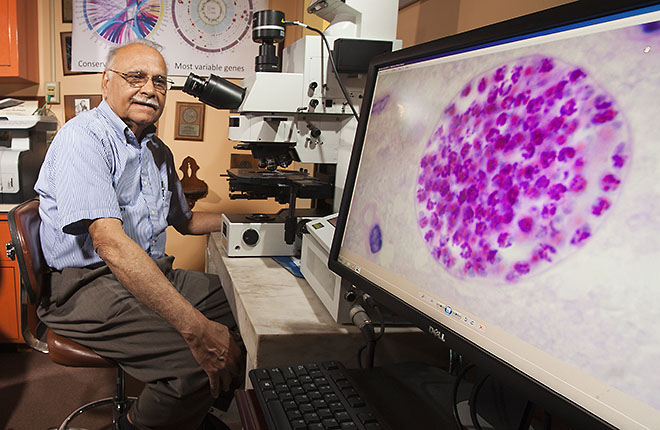How a Common Parasite in Humans Turns Aggressive
Toxoplasma gondii is a parasite that has infected an estimated one-fourth of the world’s population—potentially more than 1 billion people—including about 50 million in the United States. This makes T. gondii the most widespread parasite in the world. This one-celled parasite, invisible to the naked eye, causes a human disease called “toxoplasmosis.” It can lead to serious health complications in people with weakened immune systems and in infants born to infected mothers. Prevention is key.
T. gondii infection can happen in two ways. Cats are the only animals that shed the parasite’s egg-like sacks (cysts) in their feces—thus exposing humans and other animals to infection via contaminated soil, water, food, or litterboxes. Infection can also take place when people consume undercooked meat containing T. gondii.
Agricultural Research Service (ARS) scientists and colleagues completed a study that provides clues about T. gondii’s virulence and spread. The study describes genetic mechanisms that help a mild-mannered T. gondii strain turn aggressive.
For the study, a consortium of international researchers, including zoologist Benjamin Rosenthal and parasitologist Jitender Dubey, both with the ARS Parasitic Diseases Laboratory in Beltsville, Maryland, contributed strains of T. gondii from more than a dozen countries spanning the Americas, Europe, Africa, and Asia. The researchers conducted a genomic analysis on each of 62 strains and identified several types of proteins, called “secretory pathogenicity determinants” (SPDs) that thwart the hosts’ immunity.
Secreting SPDs enables the parasite to influence and hinder host defenses. “These proteins enhance the parasite’s survival, which in turn affects disease severity in hosts,” says Rosenthal. “SPDs have diversified more in T. gondii than in species closely related to T. gondii, so we are very curious to learn more about the functions they perform and their relationship to disease.”
The findings are helping researchers to identify the genetic basis for differences among strains of T. gondii, from mild strains found in U.S. farmlands to more virulent strains found in the jungles of Brazil and French Guyana. The researchers found that T. gondii strains could become more aggressive through environmental adaptation.
In healthy people, infection does not necessarily mean a person will become sick or develop symptoms. The study results provide valuable information about a subset of regulatory genes that enable the parasite to infect animals and humans. The findings will help researchers develop new treatments and methods to check the parasite’s ability to spread.
The study appeared in the January 2016 issue of Nature Communications.—By Rosalie Marion Bliss, ARS Office of Communications.
“How a Common Parasite Turns Aggressive” was published in the August 2016 issue of AgResearch Magazine.
Key Facts
- Toxoplasma gondii is a parasite infecting about 1 billion people worldwide.
- Some T. gondii strains are mild, and some are aggressive.
- Scientists found that T. gondii makes special proteins that defeat the host’s defenses.
Full Story







